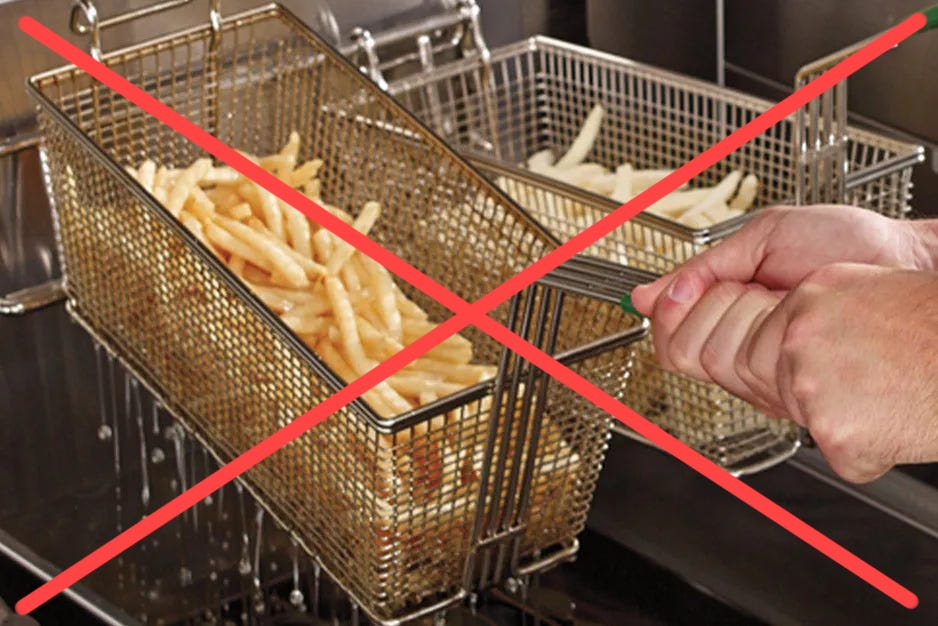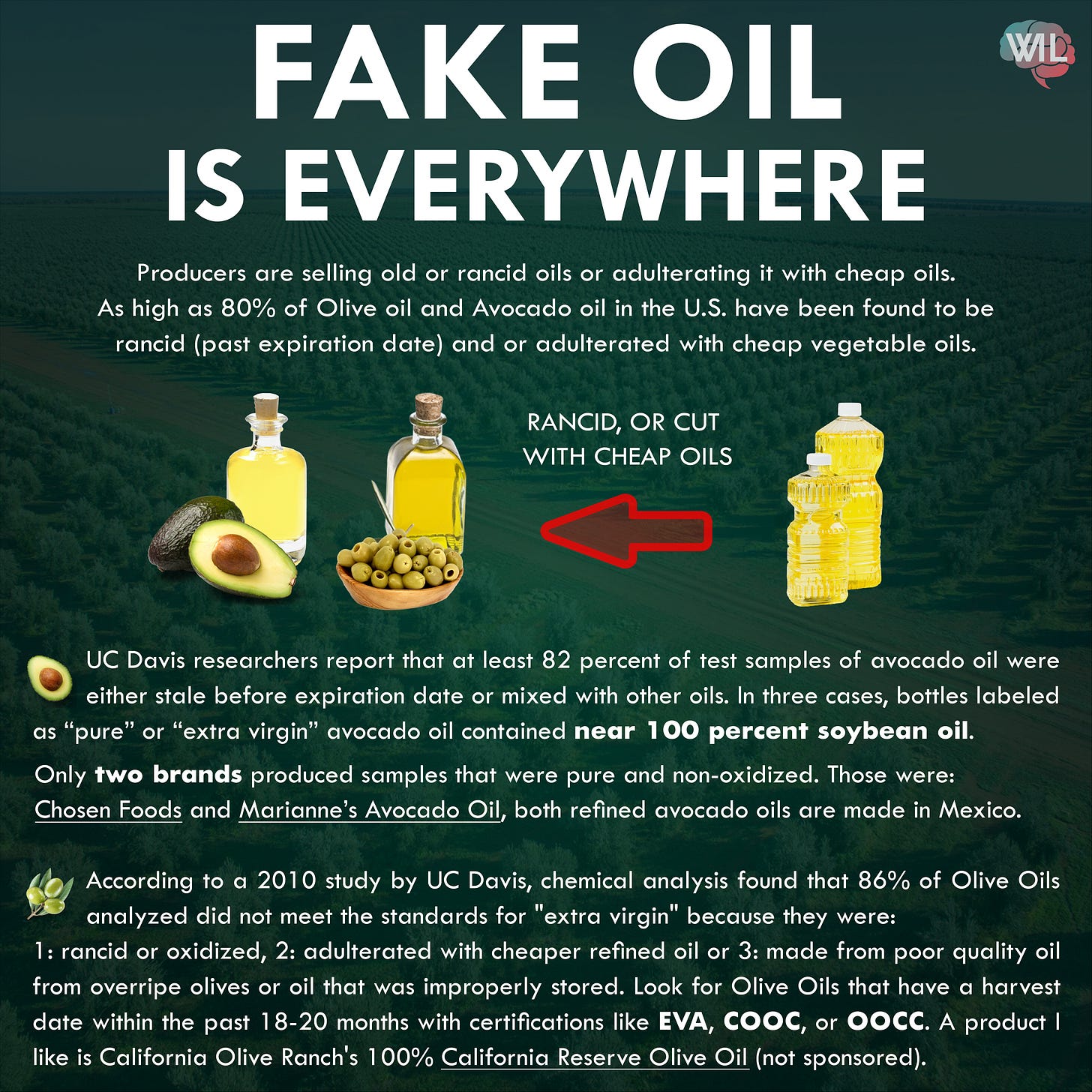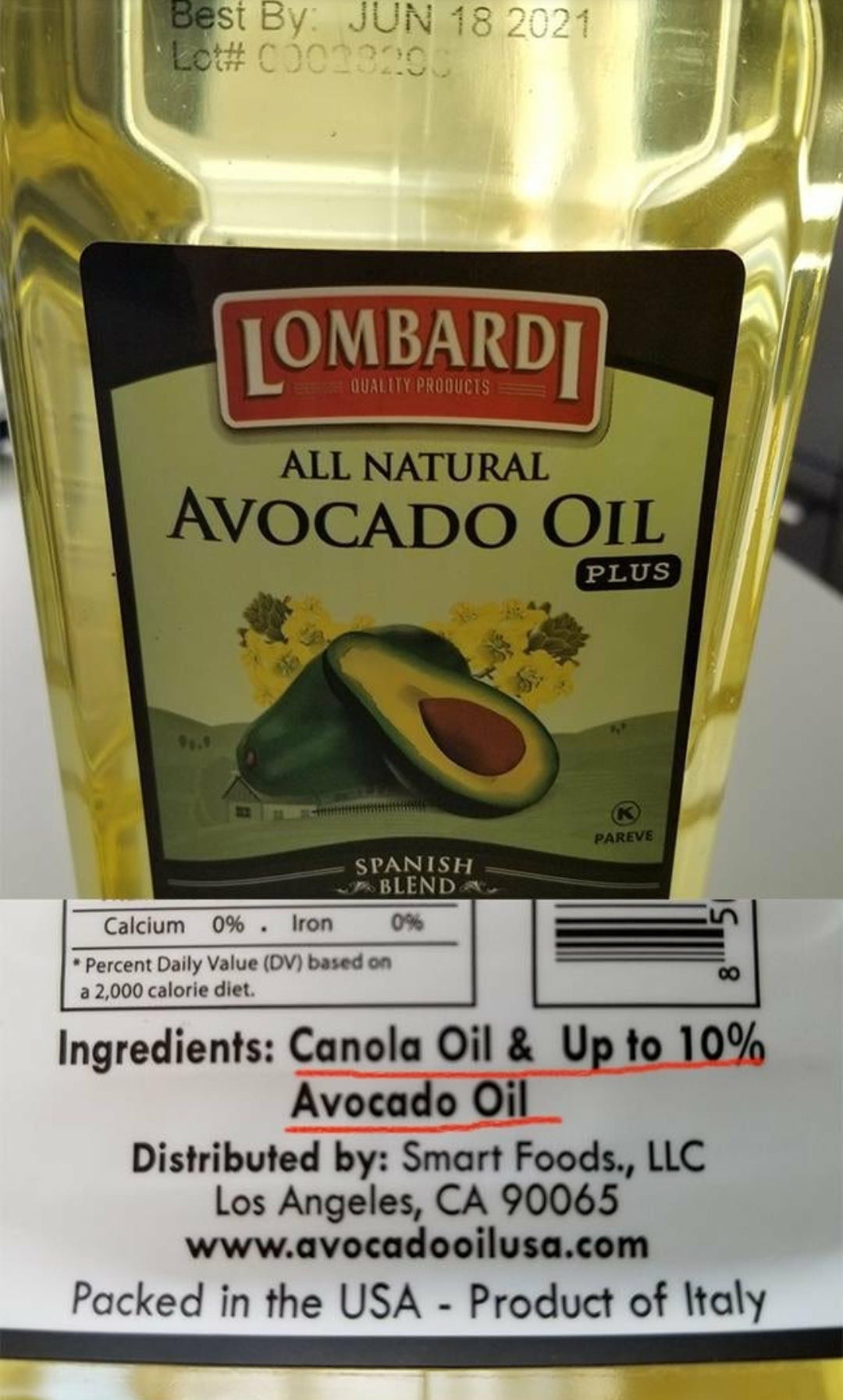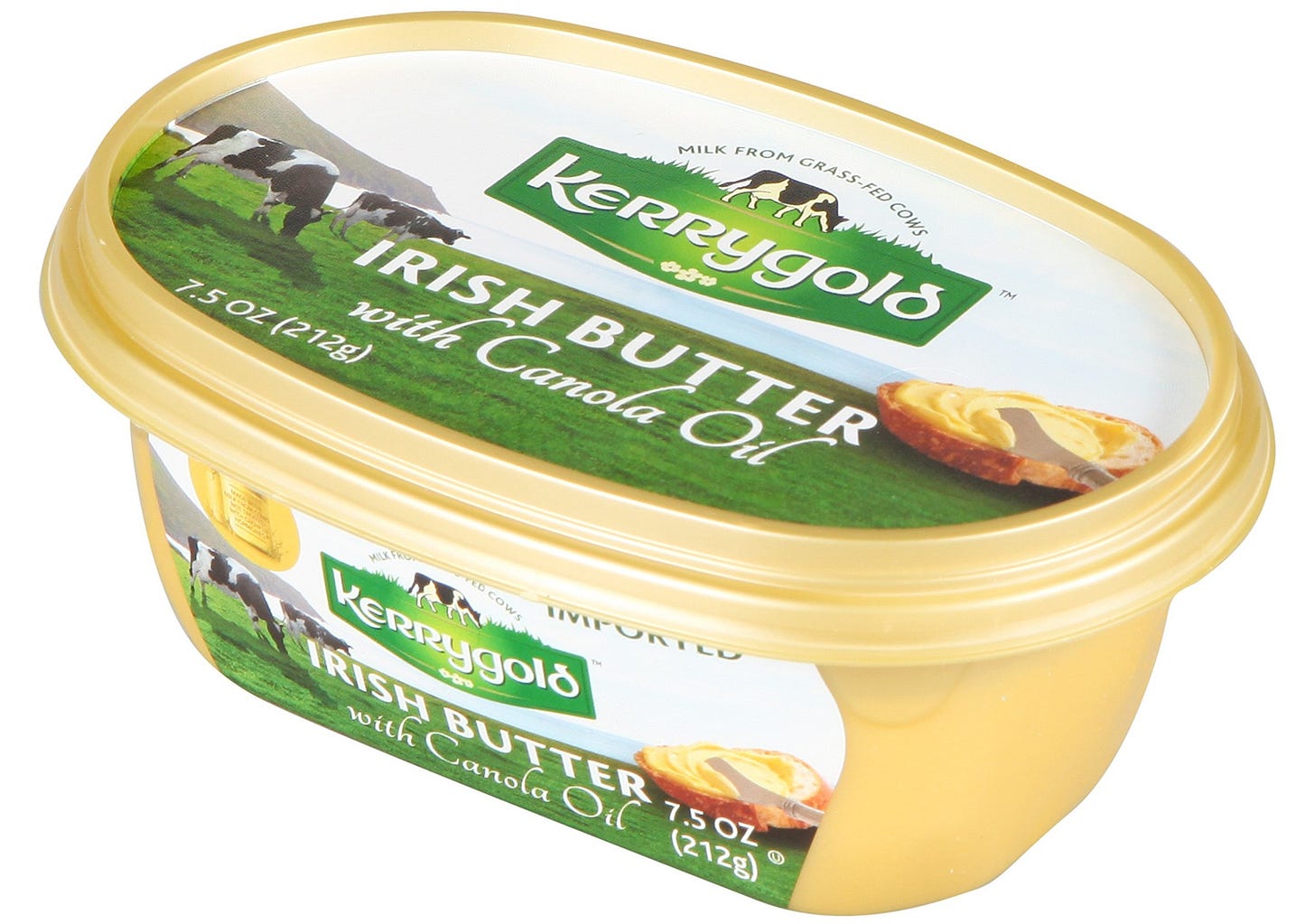The Complete Seed Oil Guide
In-depth guide on how to avoid seed oils and mitigate their negative effects
As promised, here is my guide to dealing with seed oils. As you’ve likely already seen my video from September 2021 or the one from October 1st, 2024 , let’s jump right in.
Step 1: Don’t Eat Fried Foods
If you’d like to get the worst aspects of seed oils in a highly concentrated form, eat plenty of foods fried in seed oils. In my 2021 video on seed oils, I explained that the key issue with seed oils is that the polyunsaturated fats in seed oils oxidize very easily. (Click here for the breakdown on oxidation) There are several ways you can oxidize or ‘break down’ these fragile fats: expose them to oxygen, light and especially heat. A side product of the oxidation of these fragile oils is toxic byproducts like aldehydes. Aldehydes are carcinogenic and damaging to the brain, and Dr. Martin Grootveld of DeMontfort University found a meal fried in vegetable oil such as fish and chips contains 100 to 200 times more aldehydes than the daily limit set by the WHO. So french fries aren’t just soaked in seed oils, they’re soaked in aldehyde-rich extra oxidized seed oils.
Step 2: Don’t Cook with Seed Oils
As mentioned above, the fragile polyunsaturated fats (PUFA) in seed oils oxidize very easily and are especially fragile to heat. Yet, the long industrial process that the seeds are put through to arrive at the bottles of oil you see at the supermarket already subjects the oils to very high heat. This all makes them terrible for cooking.
Linoleic acid is the fat mentioned in my my video The $212 Billion Dollar Food ingredient poisoning your Brain that competes with DHA, the fat important for development and health of the brain. Here are the seed oils arranged by linoleic acid content.*
*Note that while we’re looking at just linoleic acid here in this graphic, all PUFA is susceptible to oxidation. So for example if flaxseed were on here it would be 14% linoleic acid, but as you can see in the other graphic above, the total PUFA is actually a whopping 67%. Canola oil is 19% linoleic acid, but 28% total PUFA.
Of course animal fats and fruit oils have far less linoleic acid.
Butter, ghee, coconut oil and palm kernel oil have much less linoleic acid than lard and the fruit oils. Lard, chicken fat and the fruit oils also vary much more in their linoleic acid content.
If you use lard, pay attention to quality. The sources I was able to find suggest that the linoleic acid from pigs ranges from 8 - 11%, but I imagine it can go much higher. Since pigs are monogastrics, the fatty acid profile of their body fat is much more susceptible to reflecting their diet. I would actually specifically avoid cooking with chicken fat due to the high linoleic acid content.
Avoid chicken fat. Pasture raised chickens on a proper diet may have a linoleic acid content lower than 14%, but as you can see, it can get all the way up to 28% depending on the diet of the chicken and what part of the animal the fat is coming from.
I actually would not choose to cook with olive or avocado oil, due to the comparatively high linoleic acid content. If you’d like to make some homemade mayonnaise with it or put it on salads, that should be OK but again, we want to avoid heating these fragile oils.
Olive oil’s linoleic acid content can be anywhere from 3.5% to 21%. The linloeic acid content of the oil will vary dramatically depending on various factors with the strain of the olive being a very big one. (See the graphic at the end of this point regarding selecting a good olive oil.) If you are confident you’ve got an olive oil that is super low linoleic acid, low PUFA, then that’s much better. Olive oil can be as much as 71% monounsaturated fat. Monounsaturated fat is much more heat stable than polyunsaturated fats, but not nearly as stable as saturated fat. This is illustrated in the chart below showing that while olive oil does produce less aldehydes than PUFA-rich fat from being heated at 180° C for 30 minutes, saturated fats like butter and coconut produce far less aldehydes.
Saturated fat is best for cooking as it is most stable and resistant to oxidation. It is around 40x more resilient to oxidation than linoleic acid. Of course seed oils have a very unimpressive saturated fat content along with their high PUFA, high linoleic acid content.
In terms of just the fatty acid profile, coconut oil is quite impressive, though I don’t think many people want all their food tasting like coconut. I personally use butter and ghee for most everything as I like the flavor. I haven’t actually used palm kernel oil before, but it is supposed to be a good choice if you’re looking for a neutral flavored oil. If you’re someone who cooks and likes that vegetable oil has a neutral flavor, palm kernel oil may be a very good swap. Keep in mind that palm oil’s fatty acid profile is very different from palm kernel oil.
Something to keep in mind if you want to use olive oil or avocado oil for salads, mayonnaise etc:
Step 3: Stop using mayonnaise and oil-based salad dressings
These are often just big bottles of soybean or canola oil.
Step 4: Beware of blends
You might want some olive oil for salads or you might be reasoning that while not optimal for cooking, you’ll take an intermediate step and just switch to olive or avocado oil for now. If so, beware of blends.
Make sure to scrutinize the label of whatever you’re buying. For example this Krasdale olive oil “blend” is actually 95% canola oil.
This avocado oil “Spanish blend” is actually 90% canola oil.
Kerrygold used to be revered as the go-to source for grass fed butter, but now even they have released a butter blended with canola oil for some reason.
5. Read your food labels
This is where it gets more tricky because so many products contain seed oils. Flip the product over, find the ingredients label and just scan for the word oil. Once you get used to it, it really doesn’t take that long to just flip the product around and glance at the back before you put it in your cart.
There are several products that you can immediately guess will have seed oils in them like chips, but there are also several products that you wouldn’t expect have seed oils in them - anything from bread and crackers to lasagna or oat milk. Sometimes I’ll see sliced tuna in the fish section of a grocery story in Japan with seed oils on the label.
Note on restaurants
It can be quite hard to find restaurants that don’t use seed oils.
Seed Oil Scout is the best rated app for discovering seed oil-free restaurants that I could find. It has a score of 4.8 from 13,100 ratings. While it seems quite well populated with all kinds of listings, I unfortunately can’t attest to how good it is because the Tokyo map (where I live) only has 3 listings.
This should be a very good resource, but other than this you will need to do some investigation or ask directly to see if your restaurants have seed oil-free options.
How to recover* from seed oils
*NOTE that none of these strategies will negate the effects of seed oils. The only way to really stop the negative health effects of seed oils is to stop eating them.
1. Eat more Saturated fat
As Dr. Chris Masterjohn Phd in Nutritional Sciences explains in this video of his, it can unfortunately take as long as 4 years to completely revert back to normal after years of eating plenty of seed oils. Don’t let that discourage you as the evidence suggests that generally the lower the linoleic acid (PUFA) accumulation in your body, the better. So, your body will experience benefits as it slowly reduces amounts of this over time.
Though, what can we do in the meantime?
Well, if you swapped seed oils for saturated fat-rich cooking fats like butter, ghee, coconut oil or perhaps palm kernel oil, you’re killing two birds with one stone. In a 1968 study in The Journal of Animal Science, hogs were fed safflower oil ended up with much more linoleic acid in their fat. They could then reverse this increase of linoleic acid in the hog fat by feeding the hogs saturated fat-rich tallow for about 4-5 weeks.
Adding saturated fat along with cutting out seed oils may speed up the process of improving the fatty acid profile of your body.
Further, PUFA and saturated fat seem to have opposite effects in certain circumstances. A 2016 study in the journal Biomolecules explains that:
The protective effects of dietary saturated fat (SF) and deleterious effects of dietary unsaturated fat (USF) on alcohol-induced liver pathology are well recognized and documented in experimental animal models of ALD. Moreover, it has been demonstrated in an epidemiological study of alcoholic cirrhosis that dietary intake of SF was associated with a lower mortality rates, whereas dietary intake of USF was associated with a higher mortality. In addition, oxidized lipids (dietary and in vivo generated) may play a role in liver pathology.
While this post isn’t a guide about alcohol-induced liver damage, the point here is that saturated fat seems to have the opposite effect to PUFAs (like linoleic acid) in certain situations. For example a study looking at acetaminophen’s toxic effects on the liver found that a PUFA-rich diet worsened the liver damage but saturated fat-rich beef tallow did the opposite. The beef tallow protected the liver.
Another example is a 1989 study concluded that “dietary linoleic acid is required for development of experimentally induced alcoholic liver injury.” They fed the rodents a massive amount of alcohol and if there wasn’t enough linoleic acid in their diet, they couldn’t get the rats to develop liver injury. Again, saturated fat seemed to have the opposite effect. A 1995 rat study titled Dietary saturated fatty acids: a novel treatment for alcoholic liver disease found that a saturated-fat rich diet reversed alcoholic liver injury. Remember how the key issue with PUFA in seed oils is that the oils are easy to oxidize? Well, this study concluded that “A diet enriched in saturated but not unsaturated fatty acids reversed alcoholic liver injury” likely because saturated fat consumption reduces the oxidation of fats in the body.
One last study before we get out of the weeds and back to practical steps:
A 2012 study looked at the contents of the carotid artery plaque in patients who underwent a surgery to remove such plaque. They then looked at how the contents of the plaque related to what was in the patients’ blood as well as whether the patients were symptomatic or not. They found that:
・Patients who were symptomatic had significantly higher levels of oxidized linoleic acid (linoleic acid hydroperoxide).
・These patients had significantly higher HbA1c (a measure of blood sugar over time) and much significantly lower HDL (which raises when you eat saturated fat).
This study would suggest that the remedy is to not eat too much linoleic acid (seed oils), and eat more saturated fat to raise your HDL.
There’s a lot more to be said here, but let’s get back to practical steps.
2. Take low-dose Vitamin E
Hats off again to Dr. Chris Masterjohn for his video pointing me to this particular brand a good 7 or so years ago. Simply put:
・The reason you want a vitamin E supplement is because vitamin E is the fat soluble vitamin mainly responsible for preventing fat oxidation (lipid peroxidation).
・It’s well known that increased consumption of easily oxidizable PUFAs like linoleic acid increases your need for vitamin E.
・The reason you want low dose is because too much vitamin E may affect the balance of other fat soluble vitamins. Also, most supplements give you a crap ton (100's of mgs) of alpha-tocopherol, but loading up on alpha-tocopherol can drown out gamma-tocopherol function.
・Jarrow Formulas’ Tocosorb is particularly good due to the low dose and has a good balance of tocopherols.
・Take the supplement with the fattiest meal of your day. Dietary fat increases the absorption of vitamin E.
Note: While vitamin E is helpful for preventing more damage than necessary from seed oils, as Dr. Chris Masterjohn explains in this video, vitamin E can “never ever ever ever ever ever ever ever” protect you against consuming too much PUFA. This is because vitamin E can’t stop a peroxidation cascade from starting but it can stop it from continuing. See my explanation of a peroxidation cascade in my 2021 video here.
Scarfers the Cat - Pop Quiz
You’re a fisherman and you’re returning to the marina with a big haul of fish, looking forward to see your beloved cat Scarfers waiting for you. You take a swig of whatever fisherman usually drink and slowly dock your boat at the marina with a clean cleat hitch knot. Scarfers is there as you expected, but he looks weird - bloated and fatigued. You offer him some of the fish you just cleaned and he eats it, but slowly. He eats the fish like a kid who ate half of his halloween candy the night before and is now laboriously attempting to enjoy the rest of the candy for breakfast.
You arrive at the vet with Scarfers and the vet asks: “We don’t often see this but it seems to me scarfers has ‘yellow fat disease.’ What does he eat other than fish?”
Given the disease Scarfers has, what has he most likely been eating?
.
..
…
….
…..
That's right, Pansteatitis(yellow fat disease) is a rare condition mostly seen in carnivores not getting enough vitamin E (we do not suspect that Scarfers was poisoned or infected with a pathogen) or getting too much unsaturated fatty acids like fish oil.(R)
Animal eyes and livers contain vitamin E so the answer is (b).
The issue with yellow fat disease is that the fat of the animal or the human is inflamed and damaged due to oxidation. Again, vitamin E's key role is preventing fat oxidation (when referring to the oxidation of fats, it's called lipid peroxidation). It makes sense that you'd find vitamin E in animal fat and the liver because the antioxidant activity of vitamin E is particularly effective in high oxygen areas. Vitamin E is also concentrated in the lungs.(R)
If you’re considering non-supplement sources of vitamin E, you want to be aware of vitamin E per gram PUFA. When you consider it this way, palm oil is the best, then wheat germ oil, then olive oil, then butter (and grass fed butter is as good as olive oil).(S)
3. Mind your glutathione
If you’re doing all of the above, you’ve already doing fantastic. Though, if you’re determined to do anything that might help mitigate potential negative effects of seed oils, look into glutathione.
As page 111 of the textbook Antioxidants in Therapy and Preventative Medicine explains, glutathione is “indispensable for preventing lipid peroxidation by free radicals and oxygen.”
To support your glutathione status:
・Don’t smoke, don’t drink. Smoking and drinking are great ways to use up your glutathione.
・Selenium: make sure you’re getting enough*. Brazil nuts are the most potent source. Get enough selenium, don’t megadose it.
・ Protein. Cysteine, an amino acid found in most high-protein foods, is a limiting substrate for glutathione production.
・N-Acetyl Cysteine. Supplemental NAC is more effective at increasing glutathione levels.
・Conjugated linoleic acid. Ironically enough, an unsaturated fat called conjugated linoleic acid “strongly induces glutathione synthesis without any lipoperoxidation,” unlike other unsaturated fatty acids.
Before we wrap up, let’s take a quick look at CLA, a fat found naturally in ruminant animal food products. Ruminants include cows, sheep, goats, deer and so on.
A 2019 review explains that:
Conjugated linoleic acid (CLA), a fatty acid found naturally in ruminant animal food products, has been identified as a potential anti-obesogenic agent, with substantial efficacy in mice, and modest efficacy in obese human populations. Originally described as an anti-carcinogenic fatty acid, in addition to its anti-obesogenic effects, CLA has now been shown to possess anti-atherosclerotic properties.
That review explains how the amazing digestive system of ruminants basically magically turns crappy linoleic acid into the health promoting conjugated linoleic acid via the process of biohydrogenation. You can get CLA from the meat and milk of ruminant animals. It may take some digging to identify the best source of CLA considering “the CLA content of ruminant food products is highly dependent on various factors, such as the type of feed, age and breed of the animal, environmental season, and the rumen pH.”
































Similar to how quitting sugar helps us notice how crappy eating sugar makes us feel afterward, Soybean and canola oils now destroy my guts when I try to eat them. I use some sesame oil when I make certain dishes. Probably shouldnt.
More butter, mo betta.
Thanks for the well-packed guide.
Two small things to note.
- Japanese chicken producers are researching how to increase LA content via breeding and feed adjustments for the sake of taste. One of these groups also notes that this increase also brings various health issues with it.
- Let's not forget that eel is up there with beef liver in regards to vitamin E content. Along with that nice load of DHA.